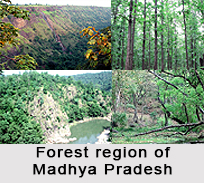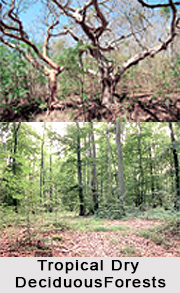 Forest vegetation in Central and North India consists of the greatest chunks of tropical moist deciduous and tropical dry deciduous forests.
Forest vegetation in Central and North India consists of the greatest chunks of tropical moist deciduous and tropical dry deciduous forests.
These forests are found practically on every soil occurring in central and north India from recent sandy alluvium to old red soils in situ. In Madhya Pradesh, Maharashtra and Odisha they even occupy laterite and black cotton soils. They occupy Indo-Gangetic alluvium and Shiwalik formations in sub-Himalayan tract.
Tropical Moist Deciduous Forests
The tropical moist deciduous forests are distributed in Uttar Pradesh (Siwalik hills, Saharanpur, Dehradun, Kumaon region, Kheri, Haldwani, Gorakhpur), Bihar (Singhbhum, Saranda), Orissa (Kalahandi, Angul, Puri), West Bengal (Tista valley, Kurseong, Kalimpong, Rangit valley, Buxa, Jalpaiguri, Bengal Duars in general), Madhya Pradesh (Supkhar, Raipur, Sitanti, Bastar, Betul, Hoshangabad) and Maharashtra (Allapalli).
 In an area having moist deciduous forests, semi-evergreen forests are frequently found on favourable sites. Near drier climatic extremes, dry deciduous forests may be closely intermixed with it. The exposed aspects bear dry deciduous forests. Dry ridges, shallow or impervious soils also bear dry deciduous forests. Moist deciduous forests predominate on rapidly drained slopes even if the climate is appropriate for wet evergreen forests.
In an area having moist deciduous forests, semi-evergreen forests are frequently found on favourable sites. Near drier climatic extremes, dry deciduous forests may be closely intermixed with it. The exposed aspects bear dry deciduous forests. Dry ridges, shallow or impervious soils also bear dry deciduous forests. Moist deciduous forests predominate on rapidly drained slopes even if the climate is appropriate for wet evergreen forests.
In Madhya Pradesh and Maharashtra teak (Tectona grandis) is the most characteristic species of tropical moist deciduous forests. Top canopy is associated with Terminalia spp, Pterocarpus spp, Lagerstroemia spp and Adina spp, etc. Dalbergia latifolia is characteristic. Xylia is generally present. Schleichera and Careya are common in second storey. Bamboosa arundinacia is typical bamboo. Dendrocalamus strictus appears at the dry ends. In the non teak bearing type, a variety of moist and occasionally evergreen species occur in mixture. In the Northern form of moist deciduous forest Sal (Shorea robusta) is characteristic. Most of the associates of southern form occur here, too. Bamboos are absent over the greater part of the type. Certain shrubs and weeds Mallotus spp, Clerodendron viscosum, Pogosteman spp, Murraya koenigii appear as undergrowth in some places. Bauhinia vahlii is the common climber. Grass undergrowth is usual.
Wildlife in Tropical Moist Deciduous Forests
| Achanakmar Wildlife Sanctuary, Chhattisgarh |
| Badalkhol Wildlife Sanctuary, Chhattisgarh |
| Baisipalli Wildlife Sanctuary, Odisha |
| Balimela Wildlife Sanctuary, Odisha |
| Barnawapara Wildlife Sanctuary, Chhattisgarh |
| Bori Wildlife Sanctuary, Hoshangabad district, Madhya Pradesh |
| Eturnagaram Wildlife Sanctuary, Warangal district, Telangana |
| Bhairamgarh Wildlife Sanctuary, Bijapur district, Chhattisgarh |
| Hadgarh Wildlife Sanctuary, Odisha |
| Indravati National Park, Bijapur district, Chhattisgarh |
| Kanha National Park, Mandla district and Balaghat district, Madhya Pradesh |
| Karlapat Wildlife Sanctuary, Odisha |
| Kawal Wildlife Sanctuary, Adilabad district, Telangana |
| Kinnerasani Wildlife Sanctuary, Khammam district, Telangana |
| Kolleru Wildlife Sanctuary, partially in the Central Deccan Plateau Dry Deciduous Forests Ecoregion). |
| Kondakameru Wildlife Sanctuary, Odisha |
| Kotgarh Wildlife Sanctuary, Odisha |
| Lakhari Valley Wildlife Sanctuary, Ganjam district, Odisha |
| Lanjamadugu Wildlife Sanctuary, Karimnagar district, Telangana |
| Mahuadaur Wildlife Sanctuary, Jharkhand |
| Pachmarhi Wildlife Sanctuary, Madhya Pradesh |
| Pakhal Wildlife Sanctuary, Warangal district, Telangana |
| Pamed Wildlife Sanctuary, Chhattisgarh |
| Papikonda Wildlife Sanctuary, Khammam district, Telangana and East and West Godavari districts, Andhra Pradesh |
| Phen Wildlife Sanctuary, Mandla district, Madhya Pradesh |
| Pranahita Wildlife Sanctuary, Adilabad district, Telangana |
| Satkosia Gorge Wildlife Sanctuary, Odisha |
| Satpura National Park, Madhya Pradesh |
| Simlipal National Park, Mayurbhanj district, Odisha |
| Sitanadi Wildlife Sanctuary, Chhattisgarh |
| Udanti Wildlife Sanctuary, Chhattisgarh |
Tropical Dry Deciduous Forests
The tropical dry deciduous forests are a mixture of trees which are deciduous during the dry season. The trees are leafless for several months. Most of these trees occur in moist deciduous forests, too. However, their development is much finer there. An undergrowth of shrub is present. Grasses, too, develop depending on the availability of overhead sunlight. Non-luxuriant bamboos are present. Canes and palms are absent. Climbers are few. Epiphytes and ferns are inconspicuous. Trees have short boles.
The form of the trees is rather poor and their height rarely exceeds 15 metres. They are distributed in Maharashtra (
Aurangabad, Bhambura, Chanda), Madhya Pradesh (
Indore,
Kannod,
Raipur,
Seoni,
Bhandara, Panchmarhi, Khargone, Betul), Uttar Pradesh (Saharanpur, Haldwani, Ram Nagar,
Bahraich,
Jhansi, Landsdowne), Bihar (Singhbhum,
Gaya), West Bengal (lateritic tracts of Bankura, Purulia, Midnapore, Sandy river banks in North Bengal) and Orissa (Sambalpur, Angul, Kalahandi).
Wildlife in Tropical Dry Deciduous Forests
In Southern form, they are grouped as teak-bearing and non-teak bearing. In the former teak (
Tectona grandis) occurs with Anogeissus latifolia and Terminalias. In the latter Anogeissus and Terminalias are mixed with Diospyros, Boswellia and Strerculia,. Dipterocarps are few. Chief bamboo is Dendrocalamas strictus. Common grasses are Heterpogon, Themeda, and Sachhrum.
In the Northern form of tropical dry deciduous forests most of the species of southern form are present. Only exceptions are teak, chloroxylon, Soymida and Cleistanthus.
Anogeissus latifolia is widely spread.
Buchnania lanzon, Stercuiia, Bauhinia and poorly grown
Terminalia tomentosa are the typical associates. Carrisa opaca, Woodfordia spp and
Indigofera pulchela are common shrubs. Heterpogon contortus and Eulaliopsis binata are common grasses.
 Forest vegetation in Central and North India consists of the greatest chunks of tropical moist deciduous and tropical dry deciduous forests.
Forest vegetation in Central and North India consists of the greatest chunks of tropical moist deciduous and tropical dry deciduous forests.
 In an area having moist deciduous forests, semi-evergreen forests are frequently found on favourable sites. Near drier climatic extremes, dry deciduous forests may be closely intermixed with it. The exposed aspects bear dry deciduous forests. Dry ridges, shallow or impervious soils also bear dry deciduous forests. Moist deciduous forests predominate on rapidly drained slopes even if the climate is appropriate for wet evergreen forests.
In an area having moist deciduous forests, semi-evergreen forests are frequently found on favourable sites. Near drier climatic extremes, dry deciduous forests may be closely intermixed with it. The exposed aspects bear dry deciduous forests. Dry ridges, shallow or impervious soils also bear dry deciduous forests. Moist deciduous forests predominate on rapidly drained slopes even if the climate is appropriate for wet evergreen forests.



















